Acute ankle and foot injuries are common in athletes and other active young people. Sprains account for the greatest number of acute injuries.
The following is information from the American Academy of Pediatrics summarizing the treatment phases of rehabilitation for ankle sprain.
Phases of rehabilitation for ankle sprain
| Phase | Summary | Description |
|---|---|---|
| I | Phase I treatment involves resting and protecting the ankle to permit healing, to prevent further injury, and to control pain and swelling. |
|
| II | Phase II treatment begins once pain and swelling have subsided to the point where the athlete can comfortably bear weight and walk from place to place. |
|
| III | Phase III treatment focuses on restoring ankle proprioception (balance and position awareness) as well as agility and coordination. |
|
| IV | In Phase IV treatment, athletes make the transition back to their sport through what is known as a functional progression. For running sports, athletes may progress from jogging or running straight ahead on a flat surface to sprinting. |
|
| V | In Phase V, the athlete has completed the functional program and should be ready to return to practice. |
|
Exercises
Peroneal strengthening exercise
Exercises that use elastic tubing can help restore strength to the muscles of the leg and calf.
-
Attach elastic to secure object.
-
Loop tubing around left forefoot.
-
Pull the tubing to the left with your forefoot while keeping the rest of your foot in place.
-
Repeat steps 1 through 3 with right forefoot pulling the tubing to the right.
Calf strengthening exercise
Calf strengthening can be performed by toe raises, with or without added weight, and toe raises on the edge of a step.
-
Stand with balls of feet on a step. Hold onto a handrail to keep you steady.
-
Keep your knees slightly bent and gently lower your heels.
-
Then slowly raise your heels by pushing on the balls of your feet.
-
Repeat steps 1 through 3.
Proprioception exercise
Exercises to restore proprioception are performed on a balance board, a wobble board, or a mini trampoline, or simply by standing on one leg while playing catch with a ball or doing some other distracting activity.
Return-to-play criteria
Because injuries and recovery rates are different for every athlete, it is difficult to estimate an exact date or time when return to sports will be safe. However, by plotting the phases of rehabilitation (see graph), doctors can discuss with athletes the necessary steps for recovery and will be able to measure an athlete's progress against this standard.
Copyright © 2011 AAP Feed run on: 10/29/2025 Article information last modified on: 1/13/2025





